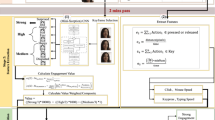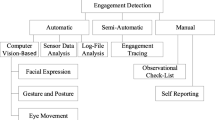Abstract
Student engagement has great impact on learning performance. It’s necessary to investigate student engagement objectively from learning behavior. In this paper, we propose a student engagement study approach in an intelligent learning environment, which automatically detects and analyses multiple learning behavioral cues based on five modules, i.e., attendance management, teacher-student (T&S) communication, visual focus of attention (VFOA) recognition, smile detection and engagement analysis. Attendance management matches the student’s identity and locates his/her profile using face recognition. T&S communication provides an additional channel of Question and Answer (Q&A) between a teacher and students for students’ behavioral engagement analysis via their cell phones. VFOA recognition is used to recognize students’ cognitive engagement through capturing students’ attention based on the estimated head poses, visual environment cues and prior states in class. Smile detection achieves students’ affective engagement through spontaneous smile expression classification. Finally, a tree-structural engagement model is proposed to decide student engagement based on multi-cues of one’s behavioral, cognitive and affective engagement. We thoroughly evaluated each module for engagement study on some public available datasets and practical video sequences in class applications. The experimental results suggest that the proposed approach can automatically detect and analyze student class engagement objectively and effectively.



















Similar content being viewed by others
References
Agarwal M, Agrawal H, Jain N, Kumar M (2010) Face recognition using principle component analysis, eigenface and neural network. In: International Conference on Signal Acquisition and Processing, pp 310–314
An L, Yang S, Bir B (2015) Efficient smile detection by extreme learning machine. Neurocomputing 149:354–363
Ba SO, Odobez JM (2011) Multiperson visual focus of attention from head pose and meeting contextual cues. IEEE Trans Pattern Anal Mach Intell 33(1):101–116
Boyle JT, Nicol DJ (2003) Using classroom communication systems to support interaction and discussion in large class settings. Research in Learning Technology 11 (3):43–57
Bradsky GR (1998) Computer vision face tracking for use in a perceptual user interface. Intel Technol J 2:1–15
Breiman L (2001) Random forests. Mach Learn 45(1):5–32
Chen D, Hu Y, Wang L, Zomaya AY, Li X (2017) H-PARAFAC: hierarchical parallel factor analysis of multidimensional big data. IEEE Trans Parallel Distrib Syst 28(4):1091–1104
Chen J, Chen D, Li X (2014) Toward improving social communication skills upon multimodal sensory information. IEEE Trans Ind Inf 10(1):323–330
Chen J, Luo N, Liu Y, Liu L, Zhang K, Kolodziej J (2016) A hybrid intelligence-aided approach to affect-sensitive e-learning. Computing 98(1-2):215–233
Cohen M, Shimshoniand I, Rivlin E (2012) Detecting mutual awareness events. IEEE Trans Pattern Anal Mach Intell 34(12):2327–2340
Dantone M, Gall J, Fanelli G, Van Gool L (2012) Real time facial feature detection using conditional regression forests. In: IEEE Conference on Computer Vision and Pattern Recognition, pp 2578–2585
Gall J, Lempitsky V (2013) Class specific hough forests for object detection. In: Decision Forests for Computer Vision and Medical Image Analysis, pp 143–157
Gourier N, Hall D, Crowley J (2004) Estimating face orientation from robust detection of salient facial features in pointing. In: International conference on pattern recognition Workshop on Visual Observation of Deictic Gestures, pp 1379–1382
Graesser A, Chipman P, King B (2007) Emotions and learning with auto tutor. Frontiers in Artificaial Intelligence and Applications 158:569
Guerra J, Hosseini R, Somyurek S, Brusilovsk P (2016) An intelligent interface for learning content combining an open learner model and social comparison to support self-regulated learning and engagement. In: Proceedings of the 21st International Conference on Intelligent User Interfaces. ACM, pp 152–163
Gui J, Liu T, Tao D, Sun Z, Tan T (2016) Representative vector a unified framework for classical classifiers. IEEE Trans Cybernet 46(8):1877–1888
Guo P, Kim J, Rubin R (2014) How video production affects student an empirical study of mooc videos. In: Proceedings of the first ACM conference on Learning@ scale conference. ACM, pp 41–50
Huang GB, Ramesh M, Berg T, Learned-Mill E (2007) Labeled faces in the wild: A database for studying face recognition in unconstrained environments. Technical report, Technical Report 07-49, University of Massachusetts, Amherst
Ito A, Wang X, Suzuki M, Makino S (2005) Smile and laughter recognition using speech processing and face recognition from conversation video. In: IEEE International Conference on Cyberworlds, pp 437–444
Kahou SE, Froumenty P, Pal C (2014) Facial expression analysis based on high dimensional binary features. In: European Conference on Computer Vision, pp 135–147
Koji Y, Atsushi I, Shinji T, Hiroharu K (2016) Analysis of computer event logs to assess student engagement in classroom: a case study in the united states. In: 12th International Conference on Natural Computation Fuzzy Systems and Knowledge Discovery, pp 2098–2101
Liu Y, Chen J, Shan C (2014) Dirichlet-tree distribution enhanced random forests for facial feature detection. In: IEEE Conference on Image Processing, pp 235–238
Liu Y, Chen J, Gong Y, Zhang K, Liu L, Luo N (2015) Robust head pose estimation using dirichlet-tree dis-tribution enhanced random forests. Neurocomputing 127:42–53
Liu Y, Xie Z, Chen J (2016) An intelligent learning system for supporting interactive learning through student engagement study. IEEE, pp 618–623
Lucey P, Cohn JF, Kanade T, Saragih J, Ambadar Z, Matthews (2010) The extended cohn-kanade dataset (ck+) a complete dataset for action unit and emotion specified expression. In: IEEE Computer Society Conference on Computer Vision and Pattern Recognition Workshops, pp 94–101
Luo C, Wang Z, Wang S (2015) Locating facial landmarks using probabilistic random forest. IEEE Sign Process Lett 22(12):2324–2328
Mi J, Lei D, Gui J (2013) A novel method for recognizing face with partial occlusion via sparse representation. Optik-International Journal for Light and Electron Optics 124(24):6786–6789
Odobez JM, Ba SO (2007) A cognition and unsupervised map adaptation approach to the recognition of focus of attention from head pose. In: IEEE International Conference on Multimedia and Expo, pp 183–191
Podder P, Paul M, Debnath T, Murshed M (2015) An analysis of human engagement behaviour using descriptors from human feedback, eye tracking,and saliency modelling. In: Digital Image Computing: Techniques and Applications, pp 1–8
Rodgers T (2008) Student engagement in the e-learning process and the impact on their grades. International Journal of Cyber Society and Education 1(2):143–156
Scornavacca E, Huff S, Marshall S (2007) Developing a sms-based classroom interaction system. In: Proceedings of Mobile Learning Technologies and Applications, pp 47–54
Senechal T, Turcot J, Kaliouby R (2013) Smile or smirk? automatic detection of spontaneous asymmetric smiles to understand viewer experience. In: 10th IEEE International Conference and Workshops on Automatic Face and Gesture Recognition, pp 1–8
Shan C (2012) Smile detection by boosting pixel differences. IEEE Trans Image Process 21(1):431–436
Siau K, Sheng H, Nah FF (2006) Use of a classroom response system to enhance classroom interactivity. IEEE Transactions on Education 49(3):398–403
Ting C, Cheah W, Ho C (2013) Student engagement modeling using bayesian networks. In: IEEE International Conference on Systems, Man, and Cybernetics, pp 2939–2944
Vazquez Rodriguez CA, Mejia Lavalle M, Pinto Elias R (2015) Modeling student engagement by means of nonverbal of nonverbal behavior and decision trees. In: International Conference on Mechatronics, Electronics and Automotive Engineering, pp 81–85
Viola M, Jones MJ (2003) Fast multi-view face detection. Mitsubishi Electric Research Lab TR-20003-96 3:14
Woolf B, Burleson W, Arroyo I (2009) Affect-aware tutors: recognising and responding to student affect. Int J Learn Technol 4(3-4):129–164
Yang C, Duraiswami R, Davis L (2005) Efficient mean-shift tracking via a new similarity measure. In: IEEE conference on Computer Vision and Pattern Recognition, pp 176–183
Zhang T, Zheng W, Cui Z, Zhong Y, Yan J, Yan K (2016) A deep neural network driven feature learning method for multi-view facial expression recognition. IEEE Trans Multimedia 18(12):2528–2536
Zhao X, Kim T, Luo W (2014) Unified face analysis by iterative multi-output random forests. In: IEEE Conference on Computer Vision and Pattern Recognition, pp 1–8
Acknowledgements
This work was supported by the National Social Science Foundation of China (Grant no. 16BSH107).
Author information
Authors and Affiliations
Corresponding author
Rights and permissions
About this article
Cite this article
Liu, Y., Chen, J., Zhang, M. et al. Student engagement study based on multi-cue detection and recognition in an intelligent learning environment. Multimed Tools Appl 77, 28749–28775 (2018). https://doi.org/10.1007/s11042-018-6017-2
Received:
Revised:
Accepted:
Published:
Issue Date:
DOI: https://doi.org/10.1007/s11042-018-6017-2




